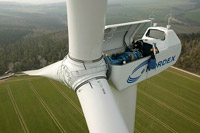Renewable Energy 'Supergrid' coming to Europe
 UK’s energy and climate change minister, Lord Hunt shares his opinion, “We recognise that the North Sea has huge resources, we are exploiting those in the UK quite intensively at the moment. But there are projects where it might make sense to join up with other countries, so this comes at a very good time for us.” Lord Hunt is talking about several North Sea countries that have coalesced for a good cause. They are aiming to create a clean and green supergrid. This supergrid will be connected to wind farms of Scotland, solar panels of Germany and hydro-electric dams of Norway. This project will be ready soon and then the first green European electricity grid will become a reality. They have expanded a network of thousands of kilometers of highly efficient undersea cables. These network cables will cost around €30bn. This way renewable energy generated in any of the North Sea countries will be available to many.
UK’s energy and climate change minister, Lord Hunt shares his opinion, “We recognise that the North Sea has huge resources, we are exploiting those in the UK quite intensively at the moment. But there are projects where it might make sense to join up with other countries, so this comes at a very good time for us.” Lord Hunt is talking about several North Sea countries that have coalesced for a good cause. They are aiming to create a clean and green supergrid. This supergrid will be connected to wind farms of Scotland, solar panels of Germany and hydro-electric dams of Norway. This project will be ready soon and then the first green European electricity grid will become a reality. They have expanded a network of thousands of kilometers of highly efficient undersea cables. These network cables will cost around €30bn. This way renewable energy generated in any of the North Sea countries will be available to many.
The supergrid will also perform the task of a gigantic 30GW battery for Europe’s alternative and clean energy. This grid will store electricity when energy demand is low. The North Sea grid would also operate as a spine of the future European electricity supergrid, where more energy will be produced from renewable energy sources. They are also trying to overcome the problem of unreliability associated with alternative energy. This supergird will have electricity available in all types of unpredictable weather because at least one phenomenon of nature will be happening such as blowing wind, lapping waves or shiny sun. Justin Wilkes, is the policy director of the European Wind Energy Association (EWEA). He said, “If Europe is able to develop a super-grid it will be a vital ingredient in the fight against climate change because it will allow large-scale integration of renewable electricity production.”
This project involves the participation of nine governments of Germany, France, Belgium, the Netherlands, Luxembourg, Denmark, Sweden and Ireland and the UK. This project will lay a milestone to the oath, European Union took, that by 2020 they will meet 20% of their energy needs from alternative sources of energy.
Hydro powered plants of Norway are equal to about 30 large coal-fired power stations. They can utilize extra energy to pump water uphill. That water will fall down again creating the necessary force to generate electricity when there is a laxity in demand. Wilkes says, “The benefits of an offshore supergrid are not simply to allow offshore wind farms to connect; if you have additional capacity, which you will do within these lines, it will allow power trading between countries and that improves EU competitiveness.”
The EWEA has conducted a study regarding the costs of connecting the proposed 100GW wind farms and building interconnectors. These interconnectors will also accommodate wind and wave power farms in future. This cost will be around €30bn. Lord Hunt is talking about the plan, “The first thing we’re aiming for is a common vision. We will hopefully sign a memorandum of understanding in the autumn with ministers setting out what we’re trying to do and how we plan to do it.”
Hunt agreed that the European supergrid will be a long term project but it will not remain in its planning phase only. They will take a concrete shape in future. Hunt agreed that The UK, like other countries, faced “huge challenges with our renewables targets. The 2020 target is just the beginning and then we’ve got to aim for 2050 with a decarbonised electricity supply – so we need all the renewables we can get.”
You can return to the main Market News page, or press the Back button on your browser.

